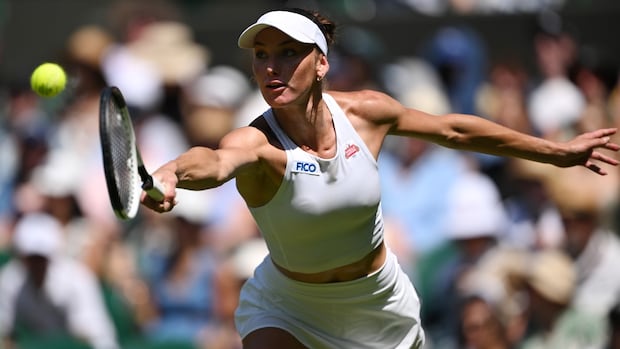Wimbedon: Few players have a female coach

WIMBLEDON, England –
On the day of the Wimbledon singles draw, Billie Jean King and other founding members of the professional women’s tennis tour gathered 5 miles away at a London hotel to celebrate the 50th anniversary of a meeting that led to the formation of today’s WTA.
That long-ago moment was fueled by frustration at paying far less in prize money than the sport’s male athletes. Despite all the progress since then, there remains one aspect of tennis in which gender equality is far from being achieved: coaching.
Of the 128 women in singles at Wimbledon, which ends this weekend, only six will work with a female coach — about 5%. All of the men’s coaches were men.
“Terrible. Extremely disappointing,” King, a member of the International Tennis Hall of Fame and rights advocate, told The Associated Press when asked about the lack of female coaches. “It’s about society, absolutely. You have to see that it is. So if you don’t see a woman up there as a coach, it doesn’t even cross your mind. How do we get the top players to hire them? ? We have to to solve the problem.’
King and others in the sport believe reflects the same deep-seated bias that has held women back from progressing in all sorts of other areas — and the WTA is pushing to change that through an initiative that pairs aspiring coaches to established coaches.
Only 13 of the women in the Top 200 have a female coach, according to the WTA; of these, four are the player’s mother.
“It’s all about equality and I would like to see an equal number of male and female coaches,” WTA Chairman and CEO Steve Simon said in an interview. “To say, ‘We should have all female coaches’ isn’t what we’re looking for either. … In a perfect world, we’d have balance.”
That is why the WTA has created a Coach Inclusion Program, which is in its first full year after a smaller pilot in 2022. Ten candidates were chosen to take classes and be matched with experienced coaches. Five shadowed coaches and players at a tournament in Charleston, South Carolina, in April; others will get that chance at events in Montreal and Cincinnati in August. The WTA plans to expand the program in 2024.
“Many of these women who participate have the same level of qualification as many of the coaches who are on tour, but they have no idea how to put themselves out there and break into it,” said Mike Anders, the program director. director. “A lot of what happens is once you get in, coaches sort of recycle themselves. So a big part is the exposure — getting both the right contacts and the right experience.”
The idea is to add candidates to the WTA’s regularly updated database of certified, eligible coaches that is part of the Player Zone, an online resource for athletes.
Currently, only 15 of the 186 active coaches are female. That’s 8%.
“There just aren’t enough options,” said Simon. “We need more women on that list.”
Why aren’t there more? One possible explanation cited by Simon, coaches and players in conversations with the AP was this: In general, the most likely path to coaching is a former player, and women leaving the tour in their late twenties or early thirties may find it harder to balance having kids with traveling the world as a coach when they stop competing.
“They have families. They become mothers. It’s easier for men to start families when they’re an ex-player. Look at me: I have a child who is 6, one who is 3 and another who is 1 1 /2. It’s inconceivable that I could take the time to coach someone,” said Flavia Pennetta, who retired shortly after winning the 2015 US Open. “Maybe I could coach later. But I can’t fully dedicate myself to a player right now.”
One of six women who coached a woman at Wimbledon this year, Pam Shriver, is a mother. For many years, she didn’t necessarily want to coach, except at her son’s high school.
But Shriver, who is also a TV commentator, is surprised that no one even approached her about it before she hooked up part-time last year with Donna Vekic, who travels regularly with another coach, Nick Horvat.
“One of the things I think about,” said Shriver, who won 21 Grand Slam titles in doubles and reached No. 3 in singles, “is that if I had been a male player with my background, my success as a player in singles and doubles, and then broadcast and watch as much tennis as I’ve observed as a broadcaster over the past few decades, I would have already been asked Sure, I would have been.
Chris Tontz, who coached American Claire Liu and mentored a few coaches at Charleston, points to a shortage of women being hired at the lower levels by clubs, academies and federations.
“It’s still a long way for women,” Tontz said. “All it takes is for someone to take a chance on them.”
One of the coaches who shadowed him in April, Iris Harris, was a talented teenager who reached the semifinals of junior doubles at Wimbledon in 2003, but her playing career was derailed when she tore a knee ligament and groin muscle. She turned to coaching and is now, at age 38, an education professional in Florida.
Harris thinks female coaches are limited by the perception that women “can get a little too emotional.” She also hears that they don’t make as good batting partners as men — even though female players don’t hit against men in competition.
“Some of us,” said Harris, “never had a chance.”
According to King and others, it is essentially not just about women’s tennis. Or even tennis.
A 2019 study by FIFA, the international governing body of football, found that more than 13 million girls and women played organized football, but only 7% of coaches worldwide were women. When the Women’s World Cup starts next week, 20 countries will be coached by men, 12 by women. In the NWSL women’s soccer league, eight clubs are coached by men, four by women. (The numbers tilt the other way in the WNBA basketball league: nine female coaches, three male coaches.)
“I don’t think anyone wants to hire a woman. It’s more that you just don’t see that many, so you always tend to hire a male coach – and there’s really no reason for that,” said Wimbledon quarterfinalist Jessica Pegula.
And of course it is not limited to sports.
“I wish there were more female coaches. I wish there were more women involved in tennis. Running tournaments. Agents. Journalists,” said 2017 US Open champion Sloane Stephens. “It’s about the business world, the everyday world, the whole world.”
Caty McNally, who reached the last two US Open women’s doubles finals, is one of the few women with a female coach.
She has two coaches: Kevin O’Neill, who tours full-time, and her mother, Lynn Nabors McNally, who travels part-time.
“My mother, in my opinion, knows as much about tennis as many men do,” said McNally. “I would never label her as a less qualified coach because she is a lady.”
Women have led women to Grand Slam titles, including two in a span of 1 1/2 months in 2017, when Anabel Medina Garrigues coached Jelena Ostapenko to a trophy at the French Open and Conchita Martinez helped Garbine Muguruza at Wimbledon.
That turned out not to be a turning point for female coaches.
Nor was the hiring of Amelie Mauresmo by three-time grand champion Andy Murray in 2014 as his coach.
“It’s strange. I’m probably surprised… there aren’t more female coaches on both tours,” Murray said. “I didn’t necessarily think at the time that there would be a whole lot of new or more female coaches coming into the game. It wasn’t exactly incredibly well received at the time. … But it’s probably a little bit more, kind of, deeper rooted, I think, then just the top of the game.”



